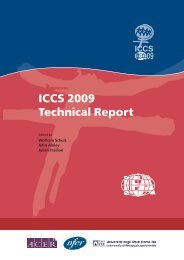Teacher Education and Development Study in Mathematics - IEA
Teacher Education and Development Study in Mathematics - IEA
Teacher Education and Development Study in Mathematics - IEA
You also want an ePaper? Increase the reach of your titles
YUMPU automatically turns print PDFs into web optimized ePapers that Google loves.
36<br />
TEACHER PAY AND STUDENT MATHEMATICS ACHIEVEMENT<br />
3. <strong>Teacher</strong> Relative Pay <strong>and</strong> Student<br />
Performance<br />
Income distribution across countries <strong>and</strong> student performance<br />
If better student performance is positively related to higher relative teacher pay because<br />
of a more equal <strong>in</strong>come distribution, we could expect, for example, that societies with<br />
a more equal <strong>in</strong>come distribution will generally be societies with relatively equitable<br />
pay scales across occupations. Thus, differences between teacher pay <strong>and</strong> pay <strong>in</strong> other<br />
occupations are likely to be smaller <strong>in</strong> these societies than <strong>in</strong> societies marked by<br />
large <strong>in</strong>come <strong>in</strong>equalities. One question we consequently decided to explore was this:<br />
Does student performance across countries <strong>and</strong> regions of countries relate to <strong>in</strong>come<br />
<strong>in</strong>equality? We considered that an answer to this question would provide a clue as to<br />
whether the ma<strong>in</strong> story about student performance <strong>and</strong> teacher pay is about <strong>in</strong>come<br />
distribution rather than societal emphasis on pay<strong>in</strong>g teachers more.<br />
To test the proposition that student performance may relate to <strong>in</strong>come <strong>in</strong>equality at the<br />
national level, we used the reported results of two <strong>in</strong>ternational tests of mathematics—<br />
Trends <strong>in</strong> International <strong>Mathematics</strong> <strong>and</strong> Science <strong>Study</strong> (TIMSS), adm<strong>in</strong>istered by<br />
the International Association for the Evaluation of <strong>Education</strong>al Achievement (<strong>IEA</strong>),<br />
<strong>and</strong> Progress <strong>in</strong> International Student Achievement (PISA), adm<strong>in</strong>istered by the<br />
Organisation for Economic Co-operation <strong>and</strong> <strong>Development</strong> (OECD).<br />
The TIMSS assessment measures have been given to fourth <strong>and</strong> eighth graders <strong>in</strong> many<br />
countries over several iterations: 1995 (also given to seventh graders <strong>in</strong> this year), 1999,<br />
2003, <strong>and</strong> 2007. TIMSS focuses on mathematics <strong>and</strong> science. The PISA assessment<br />
measures have also been adm<strong>in</strong>istered <strong>in</strong> many countries—to 15-year-olds—with<br />
iterations occurr<strong>in</strong>g <strong>in</strong> 2000, 2003, <strong>and</strong> 2006. PISA focuses on mathematics, science,<br />
<strong>and</strong> read<strong>in</strong>g. The two programs of study have somewhat different purposes: TIMSS is<br />
more <strong>in</strong>terested <strong>in</strong> assess<strong>in</strong>g the effect of curriculum differences across countries; PISA<br />
is more concerned with how well students are learn<strong>in</strong>g critical th<strong>in</strong>k<strong>in</strong>g skills needed for<br />
work<strong>in</strong>g <strong>in</strong> the 21st-century labor market.<br />
We estimated the relationship of the average test scores on the studies’ tests to <strong>in</strong>come<br />
<strong>in</strong>equality, controll<strong>in</strong>g for GDP per capita <strong>and</strong> us<strong>in</strong>g <strong>in</strong>come <strong>in</strong>equality data from all<br />
countries participat<strong>in</strong>g <strong>in</strong> TIMSS <strong>and</strong> PISA for which such data were available. There<br />
are many measures of <strong>in</strong>come <strong>in</strong>equality; each has its particular advantages <strong>and</strong><br />
disadvantages <strong>in</strong> estimat<strong>in</strong>g the distribution of <strong>in</strong>come. For our estimates, we used the<br />
G<strong>in</strong>i coefficient. We took our estimates of the coefficients from two large databases<br />
assembled by the World Bank (World Bank, 2005; see also De<strong>in</strong><strong>in</strong>ger & Squire, 1996).<br />
We regressed the average mathematics scores <strong>in</strong> each test by country on the most recent<br />
G<strong>in</strong>i coefficient (multiplied by 100) available for that country <strong>and</strong> the GDP per capita <strong>in</strong><br />
purchas<strong>in</strong>g power parity dollars (PPP$) for the year 2000. For each test, the relationship<br />
between average test score <strong>and</strong> the G<strong>in</strong>i coefficient was negative <strong>and</strong> statistically<br />
significant. The coefficient for the GDP per capita was positive <strong>and</strong> usually statistically<br />
significant (except for TIMSS 1995). Table 4 presents the results. The results suggest<br />
that the more equal the <strong>in</strong>come distribution <strong>and</strong> the higher the GDP per capita <strong>in</strong> a<br />
country, the more likely it will be that students atta<strong>in</strong> the higher average test scores. We<br />
also tried other specifications, <strong>in</strong>clud<strong>in</strong>g controll<strong>in</strong>g for the country’s total population

















